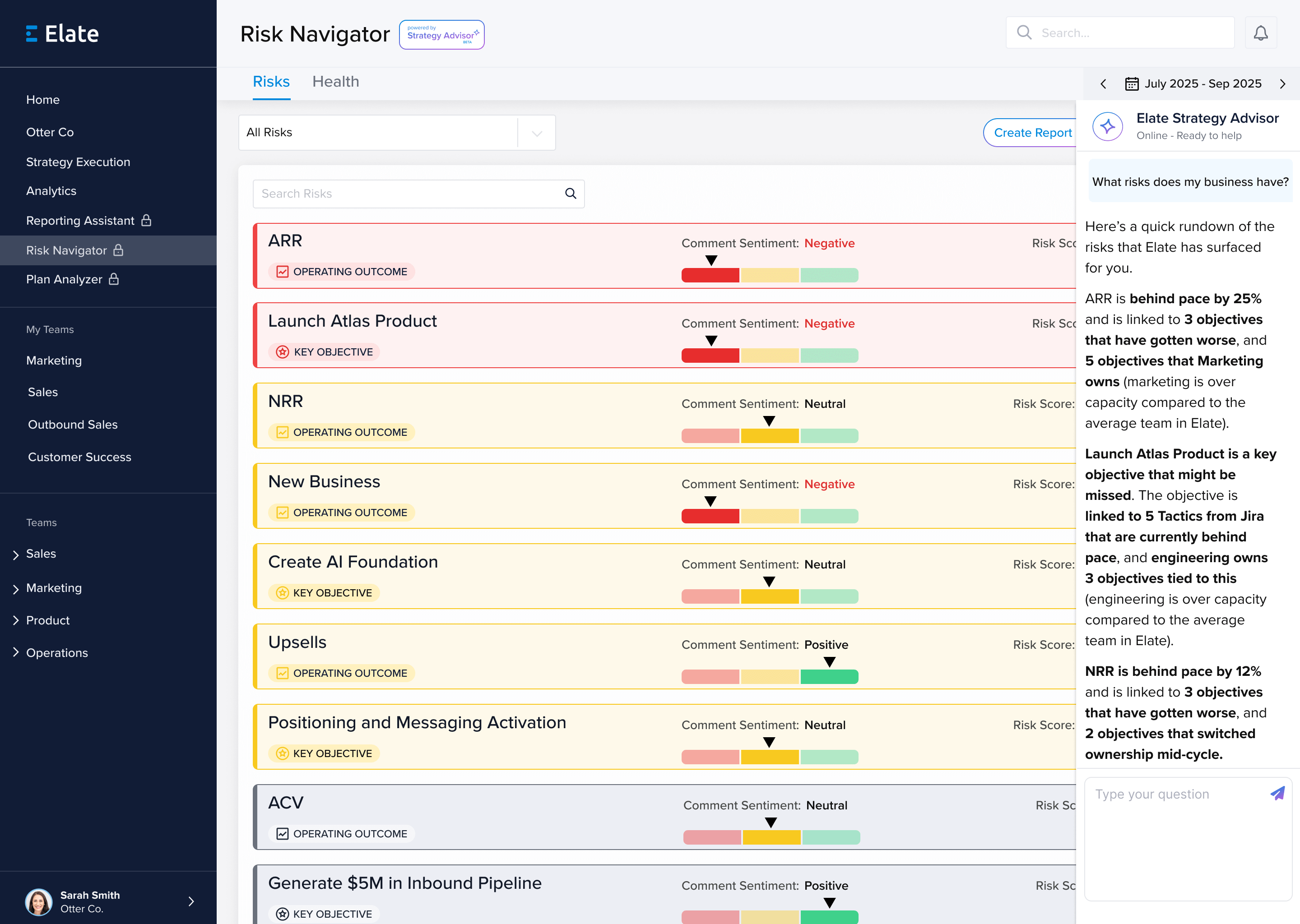For high growth companies looking to effectively scale, it becomes more and more challenging to ensure alignment across the organization. From communicating long-term vision and tracking tactical execution to creating visibility and ensuring communication, it's more important than ever before to focus on engaging employees across every layer of the business.
However, in today's landscape with in-office and remote employees, as well as the regular growing pains that come with high growth companies, it is more challenging than ever to create alignment and track performance.
Here at Elate, we have the opportunity to work with the leading strategy and operations leaders responsible for driving alignment at high growth companies. For many of these leaders, one of the most challenging questions in driving alignment across the business is figuring out how to engage employees and ensure they understand how their work is contributing towards the larger company vision.
Over the past few years one popular method for trying to create alignment and drive visibility has been performance management. From examples such as the Harvard Business Review Performance Management PDF to performance management tools focused on daily or weekly check-ins with employees, there certainly isn't a lack of performance review examples or performance review phrases that are thrown around.
However, for many strategy and operations leaders, they have seen a central tendency in performance appraisal and performance management have the opposite impact they are looking for in driving alignment. Rather than creating engagement and providing a complete view into the work being done at all layers of the business in an unbiased way, performance management tools have caused employees to feel disengaged or as though they have to punch a timecard for their work.
From how to prevent performance bias to ensuring you aren't just adding another 'to-do' to your employees regular work week, we wanted to share some of the best practices we've seen from leading strategy and operations leaders in how they implement a complete strategic planning and execution framework with performance management.
Performance Review Phrases
As we begin exploring performance management and how it fits into the overall context of strategic planning and execution, let's start by addressing some of the more common performance review phrases and concepts.
To begin addressing common challenges or pitfalls, it's important to understand that there are a number of human biases or even leniency bias that come into play. Specifically, one common example is the halo effect in performance appraisal.
To describe the halo effect, it is the tendency for a single positive rating on a performance review to cause a manager or reviewer to inflate all other ratings for that individual. An example would be if there is a specific assumption that an individual is able to achieve success in a given area or has shown the ability to achieve goals in the past. The assumption is then made that one specific rating or positive outcome from the past can impact the other measurements of that individual's performance.
The halo effect or any bias in performance management can be a challenge when a company uses subjective, opinionated methods for measuring outcomes.
At Elate, we firmly believe there is a place for subjectivity, because the narrative of a specific update that is provided by an employee on an objective or goal is incredibly valuable. However, we always encourage companies to support a specific objective or goal with a measurable, objective outcome.
As we'll discuss next, the ability to include objective and subjective performance reviews, allows you to remove yourself from biases or a static process for performance management reviews and can help elevate your company's overall performance.
How to Avoid Bias in Performance Appraisal
In asking the question, 'How can biases in performance appraisal be avoided?', it's important to understand that setting clear direction and vision for the company will help employees better understand where their work should be focused. Part of the value of providing performance reviews is helping employees understand the value of their work and their contributions towards the company goals.
For many companies, goal-setting frameworks, such as OKRs, help capture the subjective updates with the objective data supporting any goal for an individual. Additionally, by selecting a goal-setting framework like OKRs, a company can help implement an operating framework that places value on both the subjective and objective updates of an employee.
By bringing together subjective and objective data, the proper goal-setting framework can help remove bias by eliminating unmeasurable goals or goals that have no context.
The opportunity to avoid many of the biases of performance management tools and frameworks comes from being able to provide a complete view into what's going on in an employee's performance.
Additionally, implementing a goal-setting framework can help add structure to what goals employees set and why, which in turns adds to the ability for managers to remove bias and fairly engage in goal-tracking and performance appraisals.
If the company is clearly outlining what goals employees should be contributing towards, then it makes it easier to ensure those goals are being met and delivered upon. Managers don't have to take on the complete responsibility of ensuring employees are focused on the right tasks or activities, because the company has taken the time to outline a complete framework for how to set goals.
Performance Reviews Examples
In looking at examples of how to reduce bias in performance reviews, we can now start to look at an example of goals that have been set within a specific framework. Let's take OKRs (Objectives and Key Results) as our first example.
The performance reviews examples should align with the goal-setting structure our team has put in place. In this case, we have an Objective that's been set with one to three Key Results used to measure success of that Objective.
As we approach the end of the quarter, then we will ask employees to close out those Objectives. At Elate, we recommend starting with a simple, streamlined process with three questions.
1. Would you consider the objective a success?
2. How would you rate the objective on a scale of 1 to 5?
3. What would you like to share about your objective?
This provides employees the opportunity to provide context as to how the objective went, what key learnings or successes they might have had in the quarter, and how they would rate the objective.
Similarly, this provides a forum for managers to review the objective by looking at subjective and objective context. Rather than falling victim to recency bias in performance appraisal or going off of 'gut feeling', managers can view the entire outcome of the objective.
This allows for the performance review and goal-setting framework to work together in a meaningful way for the company and employees.
Performance Appraisal Problems and Solutions
So as you set out to evaluate a performance management tool, remember that performance management is only one part of the equation. The value in performance management and tracking company goals comes from the value of employees leveraging the framework and the company gaining valuable insights from the structure.
For many strategy and operations leaders, performance appraisal problems and solutions can come down to three key components: people, process, and solutions.
By bringing all three parts of the equation together, you can answer the question of how to reduce bias in performance appraisals and remove the performance appraisal bias examples so many companies fall victim to. Finding the right framework for your company is imperative for continued growth and alignment.
However, the framework must be complimented with a solution that helps employees visualize and understand how their work contributes to the larger vision, while also allowing them to surface insights that help bring value to leadership. One of the best ways to engage employees is by providing a channel to help surface areas of opportunity for leadership.
A solution like Elate can provide visibility for employees and managers to understand what's truly happening by bringing together subjective updates with objective data. Elate allows employees to engage in a meaningful way and contribute to key decisions made by the business.
So rather than using a static check-in tool, performance appraisal pdf, or even a performance review examples pdf, consider leveraging a solution like Elate that can help transform the way your company and employees think about performance reviews.
Elate is the leading Strategic Planning software built to help high growth companies communicate their vision, create alignment, and track performance all in one place. If you'd like to learn more about how our team is working with strategy and operations leaders, reach out to our team today. We'd love to share more on Elate!











